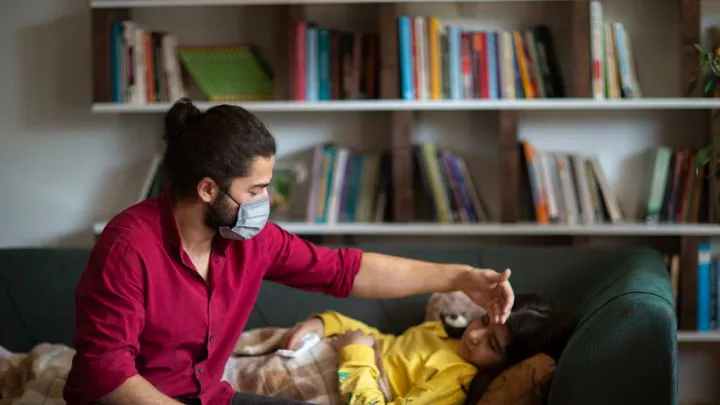
The Dreaded Stomach Flu
If you’ve ever had the stomach flu, I’m sure you can relate that it is pretty miserable. In my adult life, I have even ended up in the hospital because I got so dehydrated and weak from a case of the stomach flu and needed IV fluids to help me recover. This winter, Southern California has been hit hard with the stomach flu—more specifically called norovirus. At Children’s Hospital Los Angeles, we have seen many patients in the emergency room and on our inpatient floors with cases of norovirus. There have been many reports of schools having a significant number of absences due to norovirus this winter as well, because it is just so contagious.
Before I get any further, let’s define stomach flu, because I think that this term can be a bit confusing. The stomach flu, also called gastroenteritis, is not the same as the regular flu or influenza that causes a respiratory illness. Gastroenteritis literally means that the stomach and intestines are inflamed and irritated. The stomach flu is generally caused by viruses, but it can also be caused by bacteria. Some of the most common viruses that cause the stomach flu are norovirus and rotavirus. Rotavirus is one of the most common causes of diarrhea and upset stomach in infants and young children. You cannot be vaccinated against gastroenteritis like you can for influenza.
According to the Center for Disease Control and Prevention (CDC), rotavirus is one of the most common causes of diarrhea and upset stomach in infants and young children. Symptoms include severe watery diarrhea, often with vomiting, fever and abdominal pain. It can easily be spread among infants, young children and other people with whom they have close contact.
The norovirus causes diarrhea, nausea, vomiting, stomach cramps, muscle aches, headaches and sometimes fever. As with most causes of the stomach flu, norovirus is highly contagious and can be passed from person to person by direct contact, through infected food or water, or via contaminated surfaces. The stomach flu is also commonly spread when infected individuals don’t wash their hands after using the bathroom and then touch other people, objects or food.
Facts
- The stomach flu generally lasts about one to three days but it can last up to 10 days.
- The flu shot will not protect you against the stomach flu.
- Infants can be vaccinated against rotavirus, but this vaccine is not offered to older children or adults. There is currently no vaccine available for norovirus.
Prevention
- Wash hands well (with soap and water for at least 20 seconds) before eating, drinking, or preparing foods.
- Wash produce well before eating.
- Do not eat or prepare raw or undercooked foods.
- Infected people should avoid contact with others and should not prepare food for two days after symptoms subside.
Signs and symptoms of the stomach flu
- Diarrhea
- Vomiting
- Nausea
- Stomach cramping
- Muscle aches
- Headache
- Feeling tired/weak
- Low-grade fever
What to do if your child gets the stomach flu
- Push fluids. When children (and adults) experience multiple instances of diarrhea or vomiting it is easy to get dehydrated. It is very important to encourage your child to drink little sips of liquid at a time. It’s best to give an oral rehydration solution such as Pedialyte. Gatorade and sport drinks are okay for school-age children, but are not recommended for infants and toddlers. Avoid sodas and fruit juices as these can make diarrhea worse.
- Encourage your child to rest.
- If your child feels hungry, offer small amounts of a variety of foods along with some protein.
- Wash hands. Because the stomach flu is so contagious, make sure that you and everyone else in the household washes their hands well before eating or preparing food and after going to the bathroom. It is also very important to wash your hands after changing diapers, wiping your child in the bathroom, or cleaning up poop or vomit accidents. If possible, wear rubber gloves when cleaning. The CDC recommends washing hands thoroughly with soap and water, as hand sanitizers are not as effective against norovirus.
- Make sure to sanitize surfaces that may have become infected, such as door knobs, toilets, bathroom sinks, toys, the TV remote, etc. The CDC recommends sanitizing with products that contain bleach.
- Wash linens that may have been contaminated with vomit or diarrhea with detergent in hot water., and dry on the high heat cycle.
- Talk to your child’s doctor before giving any over-the-counter medications for diarrhea or vomiting. Often these are not recommended for children. Check with your child’s doctor regarding the best pain reliever or fever reducer as well. Never give aspirin or any products containing aspirin to children.
When to call your child’s doctor
- If your child gets a fever
- If there is blood present in your child’s vomit or stool.
- If your child looks lethargic (very sleepy or just plain “out of it”), or is extremely irritable.
- If your child cannot keep down any fluids.
- If you notice a decreased number of wet diapers, or that your child is not peeing as often as normal.
- If your child experiences other signs of dehydration such as their mouth looking very dry, if they don’t produce tears, or in an infant, if their fontanelle (soft spot) appears sunken.


